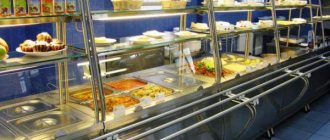How to open a pizzeria from scratch? This question is asked by everyone who wants to start this business. Pizza is the most popular dish. It's not often that you meet someone who doesn't love her or hasn't at least heard of her.
This delicious flatbread was invented in Italy, why does everyone love it so much now? In pizzerias you can relax, have a friendly meeting or a date. The pizza itself combines exquisite taste and inexpensive price. That is why a pizzeria is a profitable business. We’ll tell you where to start in this article.
Advantages and disadvantages of a pizzeria as a business
Like any business, a pizzeria has its strengths and weaknesses, which must be sorted out before starting this business.
Advantages
- low cost of making pizza;
- benefit up to 60%;
- the project will pay off in 1 or 2 years;
- constantly increasing demand for products, which will lead to increased profits;
- no need for a large number of employees;
- simple pizza making process sheet
Flaws
- high rental price;
- it is necessary to obtain all permits;
- there are many competitors in this area;
- Need management experience in restaurants or cafes
Step-by-step business plan for opening a pizzeria
Before you start working on a business plan, study the market situation and see who the leaders are. Assess their location. Find out if there is a demand for pizzerias among the population in the area. Go to a café of possible competitors and see how everything works there, what their menu is. It would be a good idea to study foreign experience.
Next comes the most crucial stage. It is necessary to carefully consider all the details of the project. First, assess your financial capabilities, demand and consumer preferences. And then you can create your picture of the business vision.
First of all, you need a business plan so that you don’t miss anything when implementing your idea. It may be useful to banks or partners if you suddenly turn to them for financial assistance.
Here are some of the most important points for your business plan:
- main idea;
- name of the pizzeria;
- location
- amount of workers;
- menu;
- the target audience;
- design project;
- advertising for promotion;
- list of necessary equipment and furniture;
- the sum of all costs, including opening;
- forecast of financial indicators.
As a result, you will end up with your own business formula. From it you will know everything from estimated revenue to production costs. It will be easier for you to navigate the numbers and make decisions regarding the choice of location, product suppliers and hiring of workers.
Deciding on the format of the establishment
The next step is to decide on the format. For a pizzeria, not only the quality of food is important, but also the design and a complete picture of your idea. You need to decide on your own style and develop a design project . You need to come up with a corporate identity that stands out from many others so that people are drawn to your pizzeria.
Maybe you decide to create a cozy family cafe with an exclusive children's menu, or will it be a sports bar where you can watch hockey and eat the most delicious pizza? There are no limits to your imagination. Just don’t lose sight of the quality, speed of service, and taste of pizzas and related dishes. Let your visitors happily return to you constantly.
There are several formats of pizzerias:
- Classic cafe-pizzeria. This is the most popular option of the establishment. Only 20 tables for visitors are needed. The menu will include pizza and other additional items. Cooking pizza takes little time and effort. The main thing is a unique recipe, fresh products and cuisine.
- Pizza bar. Youth format of pizzerias. Includes a menu of pizza varieties, a bar and, for example, desserts and French fries. People come here to chat with friends, watch matches and eat delicious food at low prices.
- Pizza shop (pizzeria-kiosk). Relatively new format. This is a small room with only a kitchen and a special area for dispensing pizza. You can get by with 3 tables for those who want to eat right in the establishment. Pizza is prepared immediately after ordering. You need to wait 20 minutes and the pizza will be ready.
- Pizzeria on wheels. Place of work - van. You can order a whole pizza or just slices. The advantage is that the business is not tied to a location. You can go to any point, especially the most crowded ones.
- Food court pizzeria. It is better to place it in some shopping center. There are always a lot of people there, especially those who want to grab a bite to eat between clothes shopping trips. You just need to find a good place to get noticed. The main thing is that you can have a tasty and quick snack. But it is worth considering the high competition. Shopping centers usually have many such food outlets.
- Kono pizza. A variant of an establishment similar to a food court pizzeria. The idea belongs to the Italians. The difference is that the pizza is served in the shape of a cone. It is similar to the usual fast food, but in more convenient packaging.
- Pizza maker. Everything is simple here. The pizza is kept in a special refrigerator, then the film is removed from it and it goes into the oven. You can buy budget machines and more technologically advanced pizza machines. The consumer can buy pizza anywhere, without having to wait for it to be prepared. Moreover, pizza will cost less than in regular pizzerias.
- Pizza delivery service. This format of pizzerias can be found everywhere. In addition to an advertising company, in which you will have to invest a lot of money, the work will require a minimum of equipment, personnel and space for making pizza. You need to work out a good advertising campaign. It would be better to create a website or mobile application and advertise in the media. Delivery vehicles will need to be purchased. Can be combined with other types of pizzerias.
Choose the best option for yourself by analyzing your financial capabilities. Start with a small kiosk, and then you can open a classic pizzeria.
Paperwork
To start a business, you cannot do without permits. You can choose any legal form.
Required documentation:
- OGRN, TIN certificate;
- fire alarm contract;
- permission from the territorial Department of Rospotrebnadzor;
- contracts for the removal of municipal solid waste, disinfection, and ventilation cleaning;
- electricity supply contracts;
- contract for water supply and sanitation;
- PPK for pizzeria;
- documents on registering the cash register;
- employment contracts with employees.
This is the bare minimum of documents you will need. You can contact special agencies to speed up the process. You also need to study environmental documentation to avoid fines for its absence.
Registration of activities
You can register your activity as an LLC or individual entrepreneur (if delivery or small initial production is expected). This article will help you choose between individual entrepreneurs and LLCs. The tax regime that meets your expectations in this business key is UTII, but the simplified tax system and OSNO will be more expensive.
In addition to tax registration, you will need the following documents:
- A permit from Rospotrebnadzor, which all catering businesses face;
- Permission from the sanitary and epidemiological station and the fire service on the safety of the premises and the possibility of its use for industrial purposes of cooking;
- Documents on the agreed removal and disposal of organic waste;
- Agreements for the provision of laundry and dry cleaning services;
- Contract for disinfection of ventilation and air conditioning systems.
If you are planning production with pizza delivery, then you must have an agreement on the disinfection of vehicles at the disposal of the pizzeria.
Choosing a location for a pizzeria
After you decide on the concept, you can go looking for a location, especially if you are going to open a stationary pizzeria.
The center of a metropolis will not be the best option, there are many competitors and high rent. But if the opening is supposed to be in a small town, then you can safely choose the center.
You can choose a populated area, closer to educational institutions, hospitals, business centers and markets. There will always be clients here. Create special offers.
When choosing a location, be guided by traffic . These could be metro stations or bus stops.
If this is a residential area, then it will be more profitable to place a pizzeria where there are high-rise buildings and residential complexes.
Pizza delivery is an additional source of income
If you are interested in the question of how to open a pizzeria in a small town, then you are probably interested in information that will help increase profits. Therefore, it is worth thinking about creating a delivery service.
If the area of your city is small, then the additional costs will not be so great.
For example, orders by phone can be taken either by a specially hired employee, or by a bartender, waiter or administrator.
You just need a person with his own car who will know the city well and handle delivery. This will help create an additional flow of customers who, for one reason or another, cannot personally visit your establishment.
Selecting a room
Do not use basements or storage areas. It is undesirable to open a pizzeria in residential buildings, but if there are no other options, then you will have to try not to disturb the residents.
All sanitary and fire requirements must be met in the premises. Availability of hot and cold water supply and sanitation is required.
Sanitary standards for the premises
Sanitary standards for pizzeria premises will be similar to those used for bakery establishments.
Basic sanitary requirements:
- if a new building is being built, a distance of 50 m from residential buildings must be maintained;
- room area of at least 100 m2;
- exclude basements and warehouses;
- availability of water supply, sanitation;
- availability of space for a kitchen, storage room, staff, and bathroom;
- waterproof floor;
- light walls painted with special water-based paint, or
- tiled to a height of 1.75 m.
- ventilation must be provided.
Selection of equipment for a pizzeria
The amount and type of equipment you will need to operate depends on the specifics of your pizzeria and its format. If it's a pizza delivery business, a good oven will suffice.
If this is an ordinary pizzeria, then one oven is not enough. You will need flour sifters, dough dividers, dough sheeting machines, vegetable cutters, mixers, ovens, deep fryers, refrigerated tables where pizza will be collected, a juicer and other equipment. There is no need to save on it . Good equipment is the key to delicious pizza . You also need to purchase refrigerators for vegetables, fish and meat.
The Internet is one of the main channels for attracting customers
Developing an effective advertising campaign is another most important task when opening a profitable pizzeria, whose main specialization is pizza delivery. The most reliable tool for promotion here is the Internet.
The combination: your own website + contextual advertising gives a colossal effect. To prove these words, just look at the statistics of Yandex search queries. Thus, the phrase “pizza delivery” for October 2020. Moscow residents searched more than 46,000 times:
And this is only in Yandex search. Don't forget that there is also Google. Every day, about 2,300 Muscovites try to find pizza delivery via the Internet. And these are direct clients.
The cost of creating a high-quality resource with a decent budget for contextual advertising will be at least 200,000 rubles. But it's a worthwhile investment. Especially if we are talking about a large city.
Deciding on the menu and choosing suppliers
Before you start, you need to find product suppliers. You need only high-quality and fresh products that will comply with GOST standards. Therefore, you need to pay special attention to choosing a supplier. Find the most reliable supplier for your main menu. Consider all proposals.
Another advantage of pizzerias is the economical use of products, since almost no write-offs occur; the products are reused.
What categories of suppliers for pizzerias will you need:
- supply of fresh vegetables;
- supply of sauces;
- supply of fresh meat;
- supply of chicken eggs;
- supply of tea and coffee
- supply of dairy products.
After opening a pizzeria, order products frequently and in small quantities, this will minimize food spoilage and simplify storage.
Draw up contracts carefully and read the terms. The required amount of raw materials will be known from the pizza manufacturing process sheet.
Recruitment
The quality of food and service in a pizzeria depends on the staff. The most important employee is the pizzailo (master of making the best pizza). The quality of your pizza depends on his qualifications and experience. Usually, the best pizzerias invite Italian masters to serve as pizzerias. But some send their chefs to master classes in Italy.
To operate the pizzeria effectively, you will need the following employees:
- pizzailo;
- assistant cook;
- waiters;
- cleaner;
- dishwasher;
- accountant (can be found through outsourcing agencies);
- administrator;
- courier (if it is a delivery service).
With this staff, the pizzeria will be open 7 days a week. When concluding contracts with personnel, make sure that they have valid medical records.
Operating procedure
The pizzeria is open daily from 10.30 to 22.00. Orders are accepted until 21.00, and after 21.30, service to visitors stops, cleaning of premises and workplaces begins.
The driver's working day starts at 8.30. Every morning, except Sunday, we go with him to purchase goods at markets or to wholesale trade centers. Some suppliers deliver goods themselves during the day.
The responsibilities of the administrator include: - monitoring compliance with labor discipline by pizzeria employees, - monitoring the sanitary condition of workers and maintaining cleanliness in the sales area, - keeping records of the remaining products in the warehouse, monitoring the norms of their consumption and deadlines for sales, - maintaining cash records of cash funds, pays wages to employees at the end of each work shift.
Also, responsibilities are divided between two administrators - one is in charge of accounting, goes to the bank and submits reports to the tax office. The other one works as a moderator on the website and on social networks, and does advertising.
Advertising and marketing for a pizzeria
The main target audience of pizzerias is people aged 18 to 35 years. Thanks to low prices for pizza, it is accessible to a wide number of consumers. When opening, carefully prepare a marketing strategy . It will consist of a corporate identity and an effective advertising campaign. You need to spend more time on the name and logo; they should be bright and memorable.
To promote your establishment on the market, you can resort to various marketing options. You can hire a promoter to distribute leaflets and flyers, advertise in print media, on radio or on TV. Install billboards, shoot videos, and most importantly, come up with unusual promotions to attract visitors.
A good move is promotion on social networks , as this method is now the most popular. Here you can let your ideas run wild and come up with competitions for “reposts” and “reviews”, hire a story maker, and launch targeted advertising. Post professional photos of the menu so you'll want to try it right away.
You can hire an SMM specialist, a copywriter, a content manager, and let your account work for profit.
If you decide to hold promotions that involve discounts, it is better to conduct them on weekdays, think about a creative slogan.
Any advertising campaign should be aimed at attracting customers. Therefore, take care of the quality of food and drinks.
We are hiring employees
Of course, having experienced employees is an important advantage of any establishment. After all, the taste, appearance and speed of serving the dishes depend on the skill of the cooks. Therefore, these positions should be given to experienced, talented people who want to learn and improve.
Don't forget about the quality of service. After all, pleasant, courteous and polite waiters are one of the keys to success. At the same time, sloppy and not very smart employees can quickly ruin the reputation of your establishment. Therefore, whenever possible, try to hire qualified employees, create a convenient work schedule and establish certain rules of conduct.
How much does it cost to open a pizzeria?
With the number of visitors 75%, the presence of 30-40 tables and a good location, the pizzeria can pay for itself in 2 years. It all depends on the format. If we consider the delivery format, the costs will be 1,000,000 rubles. For a bar you need to invest more - 1,400,000 rubles. The most expensive format is a classic restaurant, with minimal costs for furniture and equipment, you will need to invest 2,500,000 rubles.
Take into account rent and staff salaries, this takes up more than a third of expenses, the rest goes to maintaining the premises.
Profit from a business can reach 70% if you find suppliers of products on favorable terms, calculate all the risks and ensure full seating in the hall. Average figures are 30-45% . It is best to contact specialists at the initial stage.
In the third month of work we managed to break even.
By this time, a circle of regular customers had already begun to form, advertising and word of mouth began to work. In the sixth month, we managed to reach indicators that provided a small profit. Invested money. I managed to get it back only after a year of work.
Currently, the assortment includes 25 types of pizzas in two sizes.
The cost of a small pizza, depending on the filling, ranges from 200 to 340 rubles, a large one from 370 to 600 rubles.
The cost of delivery to the client’s address is 17 rubles per kilometer, if the distance is less than a kilometer, then 20 rubles.
The cost of food spent on making pizza is approximately 35%. Income received from sales is distributed as follows:
– production costs 35%, – rental and utility costs about 10%, – employee wage costs 15-20%, – delivery costs and courier fees approximately 10%, – communication costs, Internet and taxes 5- 8%.
There are also unforeseen expenses associated with unexpected equipment breakdowns, unscheduled visits by inspection authorities, advertising costs and other troubles.










